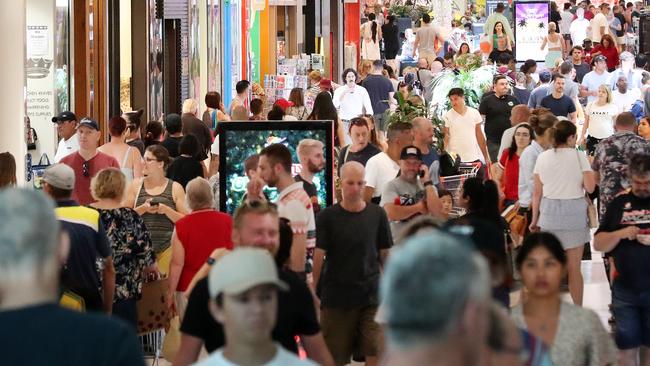Shopping shift: December retail sales sink 4.2pc
Stimulus measures failed to deliver a late-year retail boost, amid signs more Australians did their Christmas shopping in November.

Despite tens of billions of dollars of government stimulus, early withdrawal of superannuation and wages support packages thrown at consumers it failed to deliver a rise in December retail sales, casting doubt on the strength of the consumer, with Australia’s seasonally adjusted retail sales down 4.2 per cent in December.
The data also gave further evidence to the theory that Christmas sales normally done in the weeks leading up to Christmas Day are now shifting to November thanks to the rush of promotions such as Black Friday as well as consumers increasingly ordering online and anxious to ensure presents arrive on time in the mail.
The fall was compared to the performance in November, and might be a signal that shoppers brought forward their Christmas shopping early to take advantage of sales such as Black Friday which is increasingly soaking up retail sales that would have been conducted in December.
Cafes, restaurants and takeaway food services was the only sector to rise in December.
According to a preliminary estimate by the Australian Bureau of Statistics released on Friday, in seasonal adjustment terms Australian retail turnover rose 9.4 per cent in December 2020 compared with December 2019
The fall for December from November was almost three times worse than a 1.5 per cent fall expected by economists, but the Australian dollar is unchanged, because the data have been particularly volatile since to COVID-19.
Westpac economist Lachlan Halloway said the strong trade during the Black Friday sales contributed to the softer finish to the year but when looking at consumer spending more broadly despite choppy moves over the Christmas-New Year period, the bank’s Westpac Card Tracker data remains robust overall.
The Westpac Card Tracker hit a new post-COVID high in the second week of the new year, Mr Halloway said.
“After posting a sharp 9.7 point drop in the week to January 2, the Index recorded an even sharper 18.7 point jump over the week to January 9. At 119.3, the Index means annual growth in card activity is running over 19 percentage points above its pre-COVID pace.”
In terms of the new ABS retail statistics, Mr Halloway said the main driver of the contraction was a 7 per cent decline in Victoria, which follows the state’s 22 per cent gain in November on the economic reopening.
Over December falls were recorded in five of the six retail industries, led by household goods retailing, says ABS director Ben James.
Household goods retailing led the falls (down 9 per cent), following the Black Friday sales, and new product releases, that boosted turnover in November and robbed December of its traditional sales volumes.
Similarly, Other retailing, Department stores, and Clothing, footwear and personal accessory retailing, saw falls after reporting large rises in November. Food retailing fell 2 per cent, with sales across the Food industry down in Victoria and New South Wales in line with restrictions on Christmas gatherings.
Household goods retailing, other retailing, department stores, and clothing, footwear and personal accessory retailing, fell after large rises in November, when sales were underpinned by an easing of restrictions in Victoria, new product releases and Black Friday sales.
Food retailing also fell in December, as COVID-19 restrictions limited household gatherings in some states and territories. Victoria led the falls by state, down 7 per cent following a 22 per cent rise in November, while New South Wales fell 5 per cent as localised restrictions in Sydney impacted turnover. All states and territories, except for the Northern Territory, fell this month.
But there was a 2.4 per cent increase for the December quarter in current price, seasonally adjusted terms after a 7 per cent rise in the September quarter.
National Retail Association chief executive Dominique Lamb said while the seasonally adjusted figures were down compared with the previous month, this was simply a result of the extraordinary spending levels in November as state economies opened up again.
Ms Lamb said strong year-on-year growth for Australian retail in December has confirmed reports from businesses on the ground that sales before and after Christmas defied COVID close downs in some states.
“What we know for sure is that the summer retail season, which now includes Black Friday and Cyber Monday in November, has been as strong as we have seen for many years,” Ms Lamb said.
“This is partly due to the sudden reopening of state economies, particularly Victoria, during November, and partly due to the fact that Australians have more discretionary income because they aren’t able to travel widely at the moment.
“But we also know there is a rapidly rising trend of people doing their bargain hunting in November and bringing forward that Christmas gift spending, but then having a round of ‘leftovers’ on Boxing Day.”




To join the conversation, please log in. Don't have an account? Register
Join the conversation, you are commenting as Logout